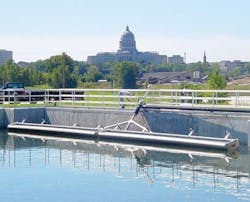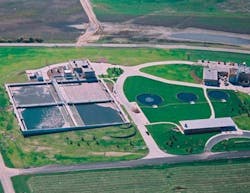Sanitaire SBR System in Jefferson City, Missouri
Jefferson City, the Capitol of Missouri, has operated a sanitary sewage collection system dating back to the 1800s. The generations of infrastructure included a trickling filter treatment plant that first entered service in 1967 and underwent major upgrades involving screening, primary clarification, and secondary treatment over the course of 1969-77. A number of operational issues had emerged by 2000 when planning began for a facility to handle the daytime capacity for a population of 50,000, high wet weather flows, effluent quality, and odor emissions. The plant had reached its capacity and was at the end of its design life, at times, operating in violation of permit requirements.
Scope
The city required a variable capacity solution that would meet current needs and also allow for peak flow rates. An improvement plan called for a 60-MGD, versus existing 25 MGD pump station, on the south side of the Missouri River that serves the majority of the service area; replacing the damaged force main atop the riverbed; and tripling the utility’s treatment capacity. The project also elevated the plant two feet above the 500-year floodplain.
“We were essentially pouring seven gallons of water into a five-gallon bucket during wet weather flows.”
Solution
An advanced Sanitaire sequencing batch reactor (SBR) system was chosen, after evaluating several treatment options, for its effectiveness at treating the City’s wastewater to current and even future objectives. The system produces effluent well within health requirements of Missouri Department of Natural Resources.
The advanced Intermittent Cycle Extended Aeration System (ICEAS) consists of four continuous inflow SBRs, which provide a more cost and operationally-effective alternative to building an additional new plant to handle the wet-weather peaks or adopting the conventional activated sludge process. Additionally, the advanced Sanitaire ICEAS System eliminates influent valves and simplifies the treatment cycle reducing the risk of failures compared to its conventional SBR counterparts.
Process oxygen is delivered through a Sanitaire fixed grid fine bubble diffused aeration system to deliver process oxygen from three, 300-HP blowers automatically balanced by dissolved oxygen feedback, modulating valves and variable frequency drives. A programmable logic controller (PLC) as part of the Sanitaire control system rotates treatment through the three process steps, and the pre-react zone effectively eliminates the need for valves feeding each tank and the contingent reliability concern.
“The advanced Sanitaire SBR technology saved nearly 30 percent in project cost and also offers a permanent reduction in operations and maintenance expense.”
Similarly, the decant system was designed without valves. This provides greater reliability and capitalizes on the inherent advantages of the advanced Sanitaire ICEAS system – excellent effluent quality, reduced odors, and a low cost, smaller footprint. In the event of a power or control failure, even under peak wet weather flows of 5X times the design average; the ICEAS tanks would continue to provide treatment.
Results
The advanced Sanitaire ICEAS fit within the existing property boundaries, delivered the needed 60-MGD peak capacity at reliable quality, and offered the inherent flexibility to comply with stricter regulations likely in the future. “The SBRs also eliminate the odors that were a major complaint about the old trickling filter plant,” Erwin emphasized. Most importantly, the Sanitaire system saved about 30 percent in project costs and offers a permanent reduction in operations and maintenance expense.
Editor's Note: Scranton Gillette Communications and the SGC Water Group are not liable for the accuracy, efficacy and validity of the claims made in this piece. The views expressed in this content do not reflect the position of the editorial teams of Water & Wastes Digest, Water Quality Products and Storm Water Solutions.

